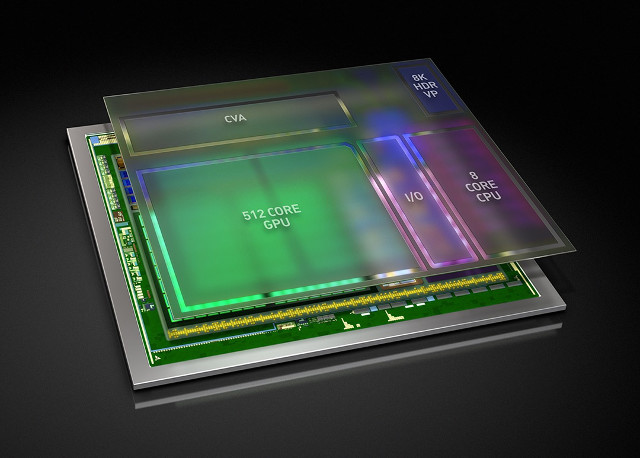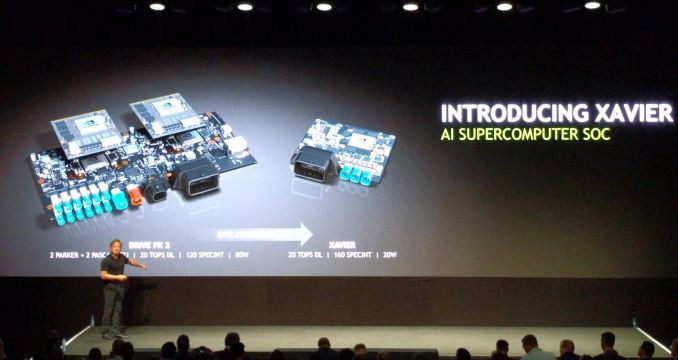Nvidia has introduced the successor to their Parker SoC mostly targeting self-driving cars and artificial intelligence applications, with Xavier SoC featuring 8 custom ARMv8 cores, a 512-core Volta GPU, a VPU (Video Processing Unit) supporting 8K video decode and encode and HDR (High Dynamic Range), as well as a computer vision accelerator (CVA).
 The processor will deliver 20 TOPS (trillion operations per second) of performance, while consuming only 20 watts of power, and since it’s designed specifically for autonomous cars, it will comply with automotive safety standards such as ISO 26262 functional safety specification.
The processor will deliver 20 TOPS (trillion operations per second) of performance, while consuming only 20 watts of power, and since it’s designed specifically for autonomous cars, it will comply with automotive safety standards such as ISO 26262 functional safety specification.
Anandtech published a comparison table with Tegra X1 (Erista), Parker, and Xavier using currently available information.
| Xavier | Parker | Erista (Tegra X1) | |
| CPU | 8x NVIDIA Custom ARM | 2x NVIDIA Denver + 4x ARM Cortex-A57 |
4x ARM Cortex-A57 + 4x ARM Cortex-A53 |
| GPU | Volta, 512 CUDA Cores | Pascal, 256 CUDA Cores | Maxwell, 256 CUDA Cores |
| Memory | ? | LPDDR4, 128-bit Bus | LPDDR3, 64-bit Bus |
| Video Processing | 7680×4320 Encode & Decode | 3840x2160p60 Decode 3840x2160p60 Encode |
3840x2160p60 Decode 3840x2160p30 Encode |
| Transistors | 7B | ? | ? |
| Manufacturing Process | TSMC 16nm FinFET+ | TSMC 16nm FinFET+ | TSMC 20nm Planar |
The company goes on to say a single Xavier-based AI car supercomputer will be able to replace today’s fully configured DRIVE PX 2 with two Parker SoCs and two Pascal GPUs. The new platform will be much smaller as illustrated below, consumes much less power at 20 Watt, or 25% of the power consumption of PX DRIVE 2, and deliver the same AI performance (20 TOPS), as well as around 33% better integer performance (160 SPECINT).
Xavier will start sampling in Q4 2017, and be available to automakers, tier 1 suppliers, startups and research institutions working on self-driving cars.
Nvidia has also uploaded a video showing the deep learning capabilities of their PX DRIVE 2 computer on a self-driving car that learned to drive in California, before driving in New Jersey.

Jean-Luc started CNX Software in 2010 as a part-time endeavor, before quitting his job as a software engineering manager, and starting to write daily news, and reviews full time later in 2011.
Support CNX Software! Donate via cryptocurrencies, become a Patron on Patreon, or purchase goods on Amazon or Aliexpress. We also use affiliate links in articles to earn commissions if you make a purchase after clicking on those links.







I see many lifes saved someday when we all use that kind of cars.
Lets celebrate a worldwide day of zero traffic deaths somewhere into 2018
You mean 2028. (If we are lucky…)